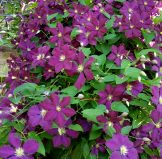
Sweet Autumn Clematis
Vines are very valuable for their versatility, variety and vigor, especially in the vertical plane. Sorry, I couldn’t resist. Many of us live in urban environments full of walls and fences, and closely packed homes with narrow side-yards. Those of us in townhomes, condos or apartments have only tiny patio gardens or balconies offering little opportunity for greening our outdoor spaces. Or, we live in new developments built on open farmland without mature trees and shrubs for shade or screening. In all of these situations, vines can quickly provide short-term or long-term solutions to provide privacy or shade, maximize our connection to the earth, block unpleasant views, cover ugly surfaces, or add a vertical dimension to the garden. And some vines can also work as groundcovers in tough situations, like under evergreen trees.
The methods by which vines climb are ingenious and varied, and they will help determine the situations for which they are best suited.

Honeysuckle
Twining: These vines wrap their stems around a support in either a clockwise or counter-clockwise direction. Well-known examples abound – Honeysuckle, Hops, Bittersweet, Wisteria, Trumpet Vine, Five-leaf Akebia, Silver Lace Vine, and many annual vines such as Morning Glory, Spanish Flag Vine, Scarlet Runner and other Beans. Most twining vines can rapidly grow up strings or cords, trellises, arbors, wrought-iron fences, chain-link and wire fences, poles and narrow posts.
Tendrils: Some vines utilize wiry, threadlike specialized ‘stems’ to explore their surroundings and sense the presence of things they can grab onto for support. Tendrils respond to touch and chemical factors by curling, twining, or adhering to suitable structures like slender stems, strings, columns, posts, fence slats, etc. and quickly coil themselves firmly around them. Classic examples of vines with tendrils are: Grapes, Virginia Creeper, Monkshood Vine, Porcelainberry Vine, Peas and Sweet Peas, Winter Squash, Cucumber, Gourds, and Passionflower.

Clematis viticella ‘Etoile Violette’
Grasping Leaf-stems: Clematis vines (not the herbaceous perennial species or the ‘scramblers’) climb by wrapping the stems of leaves around anything slender enough to grasp, including splintered wood. They climb trellises, cords, and any fences or structures that the short leaf-stems can grasp. Clematis vines are perfect for growing on trellises and draping over short fences or walls, and if the right varieties are chosen, they can be grown through roses or shrubs or to cover tree stumps. We don’t recommend growing vines through trees, as this can be problematic for both the vine and the tree.
Adventitious Roots: Some vines that produce woody stems can produce roots along their stems which anchor the stems to rough surfaces such as brick, stone, stucco, concrete or wood. These are primarily broad-leafed evergreen vines, like English Ivy, Climbing Hydrangea, or Purple-leaf Wintercreeper

Purpleleaf Wintercreeper vine
Euonymus vines, but also includes Trumpet Vine, which is not evergreen. Although they are picturesque and help merge a building with the landscape, consider carefully before planting them to climb walls because they can make building maintenance more difficult, and over time they can die back or peel off, revealing an unattractive underbelly. These evergreen vines will grow up trellises and fences by weaving through them, and while not very fast-growing, can cover an ugly chainlink fence in a surprisingly short time, providing a year-round green ‘wall’. Purple-leaf Wintercreeper is also one of the only plants that can succeed as a ground-cover in very dry shade under Spruce trees and other dense conifers. Both English Ivy and Euonymus change their leaf-form when they grow vertically, and will only bloom and fruit when upright.
Harlequin’s Gardens is well-stocked with a wide selection of vines for every situation, and we have beautiful trellises, too! We’d love to help you find the right vines for your garden.
